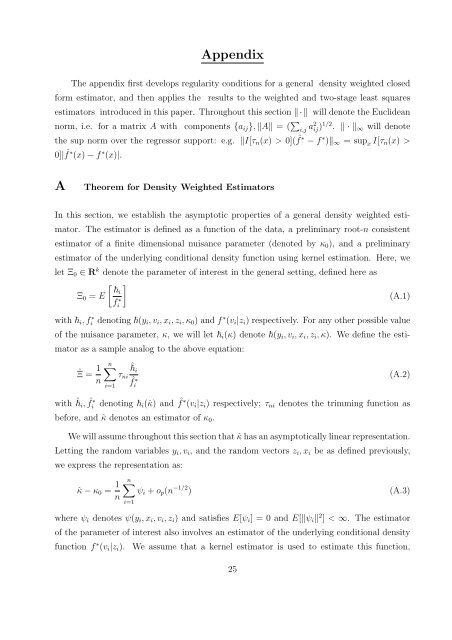weighted and two stage least squares estimation of ... - Boston College
weighted and two stage least squares estimation of ... - Boston College
weighted and two stage least squares estimation of ... - Boston College
You also want an ePaper? Increase the reach of your titles
YUMPU automatically turns print PDFs into web optimized ePapers that Google loves.
Appendix<br />
The appendix first develops regularity conditions for a general density <strong>weighted</strong> closed<br />
form estimator, <strong>and</strong> then applies the results to the <strong>weighted</strong> <strong>and</strong> <strong>two</strong>-<strong>stage</strong> <strong>least</strong> <strong>squares</strong><br />
estimators introduced in this paper. Throughout this section · will denote the Euclidean<br />
norm, i.e. for a matrix A with components {aij}, A = ( <br />
i,j a2 ij) 1/2 . · ∞ will denote<br />
the sup norm over the regressor support: e.g. I[τn(x) > 0]( ˆ f ∗ − f ∗ )∞ = sup x I[τn(x) ><br />
0]| ˆ f ∗ (x) − f ∗ (x)|.<br />
A Theorem for Density Weighted Estimators<br />
In this section, we establish the asymptotic properties <strong>of</strong> a general density <strong>weighted</strong> esti-<br />
mator. The estimator is defined as a function <strong>of</strong> the data, a preliminary root-n consistent<br />
estimator <strong>of</strong> a finite dimensional nuisance parameter (denoted by κ0), <strong>and</strong> a preliminary<br />
estimator <strong>of</strong> the underlying conditional density function using kernel <strong>estimation</strong>. Here, we<br />
let Ξ0 ∈ Rk denote the parameter <strong>of</strong> interest in the general setting, defined here as<br />
<br />
i<br />
Ξ0 = E<br />
f ∗ i<br />
(A.1)<br />
with i, f ∗ i denoting (yi, vi, xi, zi, κ0) <strong>and</strong> f ∗ (vi|zi) respectively. For any other possible value<br />
<strong>of</strong> the nuisance parameter, κ, we will let i(κ) denote (yi, vi, xi, zi, κ). We define the esti-<br />
mator as a sample analog to the above equation:<br />
ˆΞ = 1<br />
n<br />
n<br />
ˆi<br />
τni<br />
ˆf i=1<br />
∗ i<br />
(A.2)<br />
with ˆ i, ˆ f ∗ i denoting i(ˆκ) <strong>and</strong> ˆ f ∗ (vi|zi) respectively; τni denotes the trimming function as<br />
before, <strong>and</strong> ˆκ denotes an estimator <strong>of</strong> κ0.<br />
We will assume throughout this section that ˆκ has an asymptotically linear representation.<br />
Letting the r<strong>and</strong>om variables yi, vi, <strong>and</strong> the r<strong>and</strong>om vectors zi, xi be as defined previously,<br />
we express the representation as:<br />
ˆκ − κ0 = 1<br />
n<br />
n<br />
i=1<br />
ψi + op(n −1/2 ) (A.3)<br />
where ψi denotes ψ(yi, xi, vi, zi) <strong>and</strong> satisfies E[ψi] = 0 <strong>and</strong> E[ψi 2 ] < ∞. The estimator<br />
<strong>of</strong> the parameter <strong>of</strong> interest also involves an estimator <strong>of</strong> the underlying conditional density<br />
function f ∗ (vi|zi). We assume that a kernel estimator is used to estimate this function,<br />
25

















